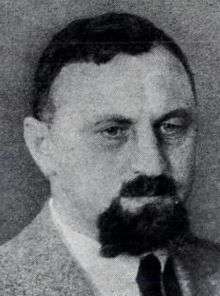Johannes Bøe (archaeologist)
Johannes Bøe (January 17, 1891 – February 1, 1971) was a Norwegian archaeologist.[1][2]
Johannes Bøe | |
|---|---|
 | |
| Born | January 17, 1891 |
| Died | February 1, 1971 (aged 80) |
| Occupation | Archaeologist |
| Children | Alf Bøe |
Career
In 1921, Bøe received his candidatus philologiæ degree with the thesis Norske guldfund fra folkevandringstiden (Norwegian Gold Finds from the Migration Period). In 1931 he received his doctorate with the dissertation Jernalderens keramikk i Norge (Iron Age Ceramics in Norway). In 1921 he was appointed a researcher at the University Museum of Bergen, and he was later a research professor at the same institution.[1]
Bøe was distinguished by his exceptionally rich scholarly production, ranging from the early Stone Age to the Iron Age. His best-known work, alongside his doctoral dissertation, is Le Finmarkien: Les origines de la civilisation dans l'extreme-nord de l'Europe (Finnmark: The Origins of Civilization in the Far North of Europe), which he coauthored with Anders Nummedal and in which they established the Komsa culture as having its own status in the Norwegian Stone Age.[1]
Family
Bøe was born in Ringsaker, Norway,[1][2] the son of John O. Bøe (1851–1910) and Marie Nilsdatter Bjerke (1859–1953). His father was a farmer at the Ottersrud farm. Bøe married Dagny Godager (1896–1982) in 1920 and was the father of the art historian Alf Bøe (1927–2010).[1]
Awards and recognitions
- Fridtjof Nansen Prize for Outstanding Research, 1932, for his work on Iron Age pottery in Norway[3]
References
- Solberg, Bergljot (2014). "Johannes Bøe". Norsk biografisk leksikon (in Norwegian). Retrieved January 12, 2020.
- Solberg, Bergljot (2018). "Johannes Bøe". Store norske leksikon (in Norwegian). Retrieved January 12, 2020.
- "Den historisk-filosofisk klasse 1900–1940". Nansenfondet. Det Norske Videnskaps-Akademi. Retrieved January 12, 2020.